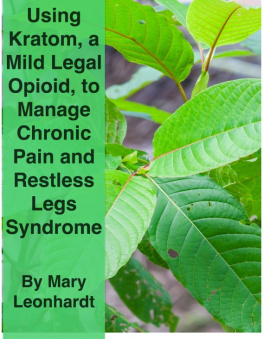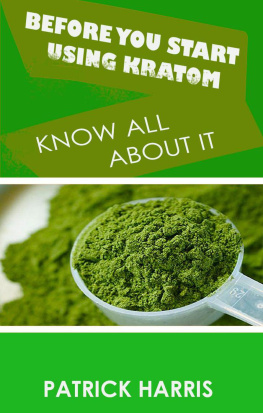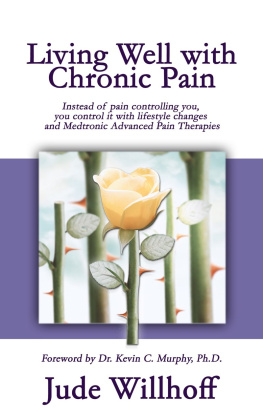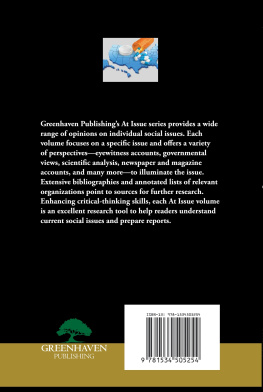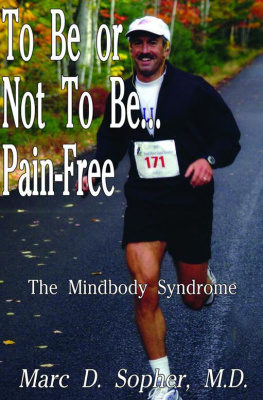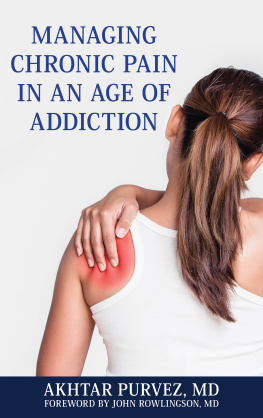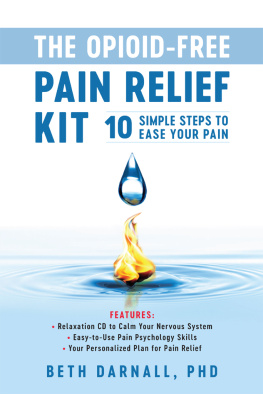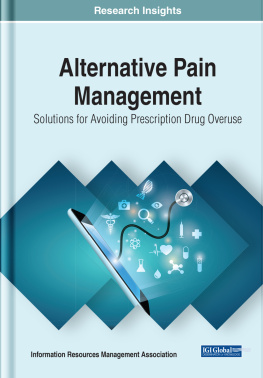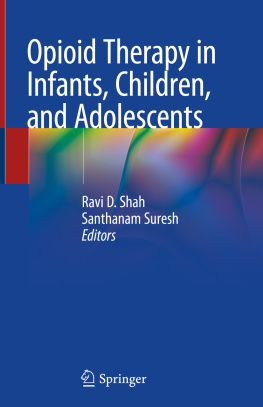Using Kratom, a Mild, Legal Opioid, toManage Chronic Pain and Restless Legs Syndrome
By
Mary Leonhardt
Using Kratom, a Mild, Legal Opioid, to ManageChronic Pain and Restless Legs Syndrome
By Mary Leonhardt
Copyright 2014 by Mary Leonhardt
All Rights Reserved
Published by Mary Leonhardt at Smashwords
Table of Contents
This is a book about my personal experienceswith kratom. I write about it as a sufferer of chronic pain, andsevere restless legs syndrome (RLS).
I am not a doctor. I am not a medicalresearcher. I did do some research about kratom, before I startedusing it, but I used only sources that are available toeveryone.
I am not advising anyone else to use kratom,as I dont think I have any right to do that. I am just telling youmy experiences.
I know that both chronic pain, and RLS, arecomplicated conditions, and may respond to different treatments indifferent people. Kratom may not work for you.
But it has been a wonderful, life-saving herbfor me. And so I wanted to pass along my story.
Im seventy years old, and can barelyremember a time when I wasnt bothered by restless legs syndrome,and by chronic back pain. The back pain I could manage pretty wellwith daily exercises. For most of my life, the RLS--thoseunpleasant, crawly sensations in my legs that made it imperativefor me to move aroundwere intermittent and fairly mild. I couldmanage them with a short walk, a hot bath, or a variety of over-thecounter remedies. Then, about three years ago, the RLS became muchmore severe, and my back pain was starting to need more than dailyexercise.
I went to a chiropractor for my back pain. Ihad an MRI and was diagnosed with mild degenerative disc diseaseand moderate to severe facet joint osteoarthritis, as well asmoderate narrowing of the spinal canal, secondary to some discbulging. The exercises and the chiropractor helped, and if that hadbeen my only problem, I would have been okay. Yes, the pain wasoften troubling, but I had no desire to go on heavy painmedications. When I got very uncomfortable, Advil usually helped,although I worried sometimes that I was taking too much of it.
In addition to the back pain, a few years agoI developed shoulder pain, with inflamed rotator cuffs. I also doexercises for my shoulders, which help quite a bit and, again,Advil helped.
But, meanwhile, the RLS was getting muchworse, and nothing I was taking seemed to help it. Gradually, itwasnt just one or two nights a month that I was awakened by theabsolute need to get out of bed and start walking; it was everynight. And not just once or twice a nightsometimes, it seemed, theentire night. From being a good sleeper, I started averaging onlytwo or three hours of sleep a night. Some nights I barely slept atall, in spite of all of the over-the counter remedies that used towork, as well as two or three hot baths.
In addition, being able to sit and read orwatch a video on the couch in the evening became impossible. Afteronly a few minutes, the feeling in my legs made me get up and movearound. I stopped even trying to go to movies or a show in theevening.
One of my children lives across the countryfrom me, and one lives in Hawaii. I found I was also now dreadingairline flights. Even though the RLS was most disabling at night,it seemed that no matter what time I scheduled an airline flight,my legs acted like it was the middle of the night. Having to sitthrough a long flight had gone from being bothersome to beingalmost unbearable.
So I started doing research. The back painwas no mystery; exercise Advil, and some visits to the chiropractorcould keep it somewhat in check. But I had no idea what to do forthe RLS.
I searched restless legs syndrome and readeverything I could find on it. Heres the short version:
Restless legs syndrome has been renamedWillis-Ekbom Disease (WED), principally, I gathered, because themedical profession was now understanding the seriousness of theconditionand restless legs doesnt sound that serious. But sinceRLS is the more common name, Ill use that term in this book.
It turns out that, although there are manytheories of its cause--usually centering around a lack of dopamine,or a lack of iron, or too much glutamate--no one knows why someonedevelops it, or how to cure it. That last part was very clear: noone had a cure for RLS. The most to hope for was that some waywould be found to manage it.
The only glimmer of hope I found in myresearch was the theory that some cases of RLS were secondary tosome other, treatable conditionsuch as low iron, or low vitamin D.Pregnancy seemed to cause a flare-up of it, and it seemed toaccompany some other diseases, such as Multiple Sclerosis andDiabetes. The hope was that managing these other diseases--orwaiting for the pregnancy to end--would also cause a remission ofthe RS.
Its hard to get accurate statistics on howcommon the condition is, since many sufferers dont realize thatits a definite disorder, and so dont seek medical help. However,the National Institute of Neurological Disorders and Stroke (NIH)estimates the percent of people affected may be as high as tenpercent, with two to three percent of the population havingmoderate to severe RLS. NIH also estimates that as many as amillion children may be affected. I find this especiallyheartbreaking, as kids being diagnosed as hyperactive, orbehavior-disordered, may be suffering from RLS. They wont sitstill when told to because they cant.
The best medical description of the conditionI found was in a book titled Clinical Management of RestlessLegs Syndrome by Hochang B. Lee, Mark J. Buchfuhrer, RichardAllen, and Wayne A. Hening. Its available on Amazon, and I highlyrecommend it. Get the second edition. It lists five diagnosticcriteria for RLS which are, essentially, that sufferers feel acompulsion to move their legs, the compulsion is strongest after aperiod of rest, movement relieves the compulsive feeling, the urgehappens mostly in the evenings and at night, and this compulsion tomove is not caused by anything else.
This book, Clinical Management, alsooutlines treatment options. Essentially, it recommends first to dothe kinds of things I was already doing: exercise, watching mydiet, hot baths, etc. When these mild interventions stop working,it recommends a class of drugs called dopamine agonists (DAs). Insearching the Internet, I found that, indeed, most sufferers ofthis disease report that these are the drugs most prescribed.
The most helpful site I found on the Internetwas that of the Willis Ekbom Disease (RLS) Discussion Board: http://bb.rls.org
I spent a good deal of time reading postingsfrom this discussion board, and a couple of things jumped out atme.
One was that most people who bother to postare those suffering the severe form of RLS. So this was definitelymy group. And many had been struggling with severe RLS for years,and had undergone all of the available treatments.
It was their experiences that I was mostinterested in, as I was trying to decide what to do myself. I knewI had to do something, as the RLS was now having a major, negativeimpact on my life. Combined with my chronic back pain, it wasmaking my life very difficult. It seemed like I was exhausted andin pain much of the time.
Almost uniformly, the posters reported beingput on a DA by their doctors (usually neurologists or primary caredoctors) after their RLS became severe. The good news was that theDAs seem to control RLS symptoms pretty well. But, for me, the badnews almost overwhelmed the good news.
First of all, there are significant sideeffects to the DAs. Common ones are headaches, nausea, and eithersleepiness, or trouble sleeping. More severe ones includedcompulsive behavior, such as gambling, or compulsive eating.
That was troubling enough, but for me theshowstopper was that in some casesand Ive seen statistics allover the place as to how many casespeople on DAs eventuallyaugment. This means their RLS gets worse. While before starting theDAs the symptoms were confined primarily to their legs, andhappened primarily in the evenings and at night, after being on aDA it sometimes started happening all over their bodies, and wasactive twenty-four hours a day.

